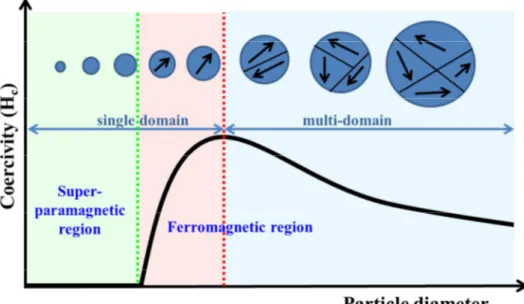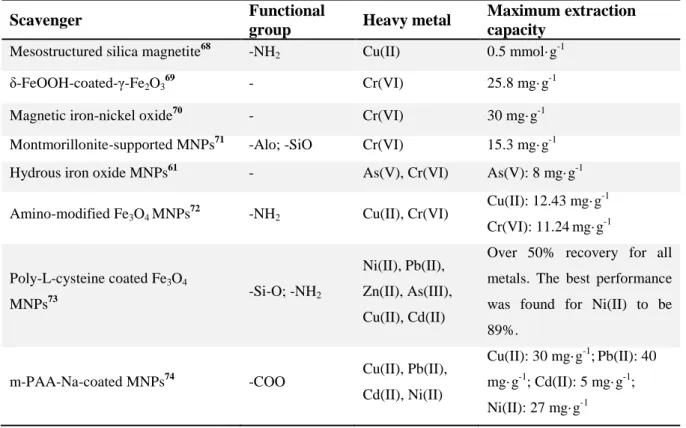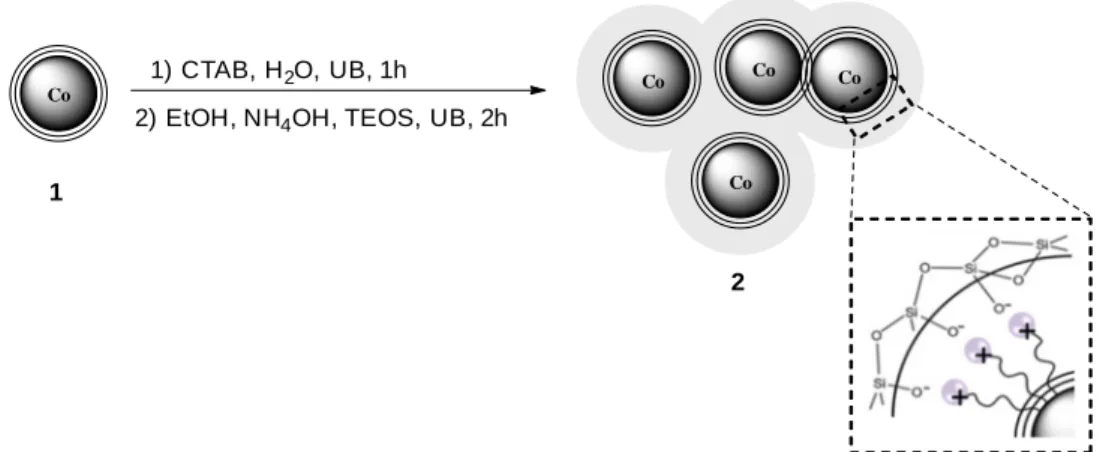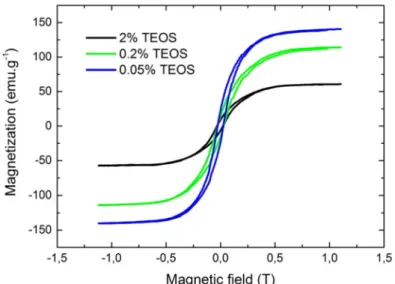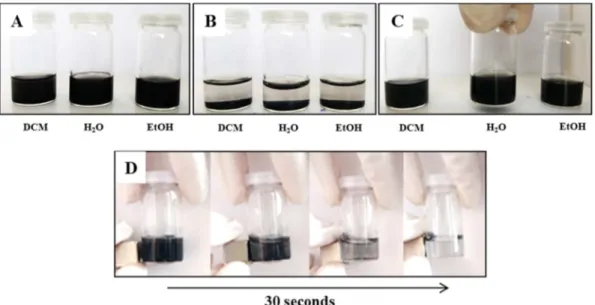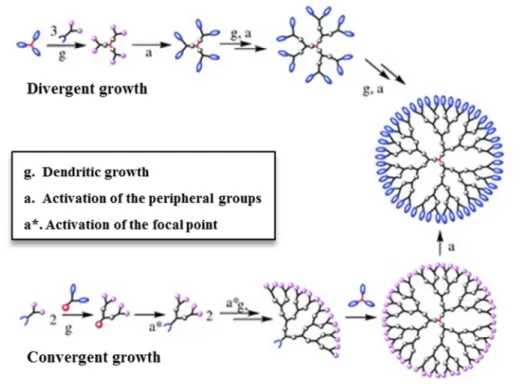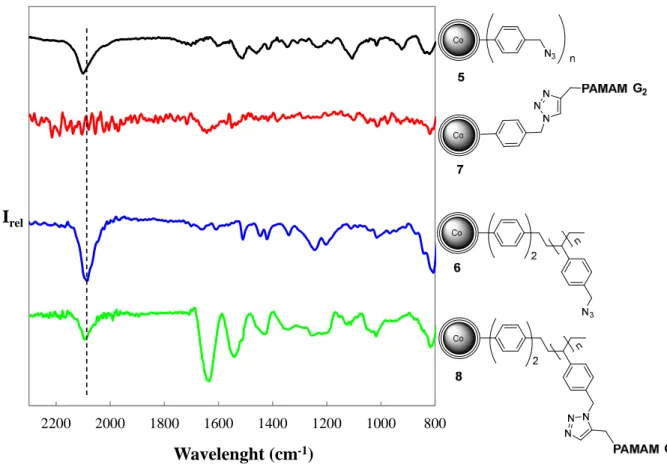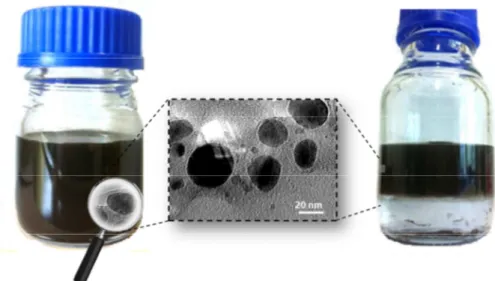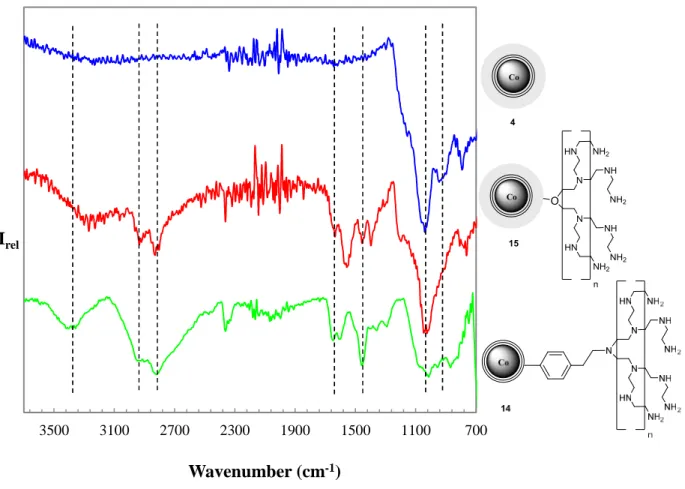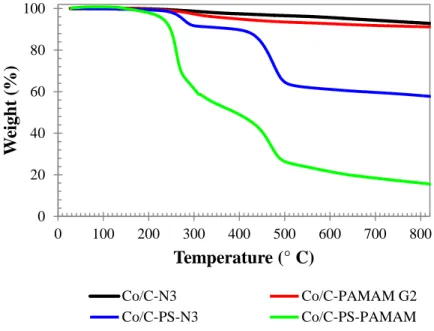From bioremediation to biomedicine:
the potential of magnetic nanoparticles in a glance
Doctoral Thesis presented by
Soraia Fernandes
for the degree of
Doctor of Sciences by the University of Regensburg and
Doctor in Chemistry and Materials Sciences and Technologies by the University of Genoa
Regensburg 2016
This work was supervised by: Prof. Dr. Oliver Reiser Graduation request filled on: 11. April 2016
Oral examination done on: 11. May 2016
Examination Committee: Chairman: PD. Dr. Sabine Amslinger (University of Regensburg) 1. Examiner / supervisor: Prof. Dr. Oliver Reiser (University of
Regensburg)
2. Examiner / tutor: Dr. Teresa Pellegrino (Istituto Italiano di Tecnologia)
3. Examiner: Prof. Dr. Joachim Wegener (University of Regensburg)
4. Examiner: Prof. Dr. Sara Baldassari (University of Genova) 5. Examiner: Prof. Dr. Renata Riva (University of Genova)
This thesis was performed inside the EU-ITN network Mag(net)icFun in accordance to the cotutelle agreement made between the University of Regensburg and the University of Genova for a joint PhD degree programme.
The experimental work from February 2013 to March 2015 was done under the supervision of Prof.
Dr. Oliver Reiser, at the Institut für Organische Chemie der Universität Regensburg. From April 2015 to January 2016 the experimental work was carried out at the Nanomaterials for Biomedicine group of the Istituto Italiano di Tecnologia (IIT, Genoa) under the supervision of Dr. Teresa Pellegrino.
Table of contents
Thesis abstract 1
Zusammenfassung 3
Riassunto 5
Introduction: The potential of magnetic nanoparticles in a glance 7
1. Magnetic nanoparticles: motivation and overview 7
2. Basics of magnetism for nanoparticles 8
3. Surface coating effects on the magnetic properties of nanoparticles 11
4. Applications of magnetic nanoparticles 14
4.1. Nanoparticles as potential tools in industry 14
4.1.1. (Bio)Catalytic applications 15
4.1.2. Environmental applications 17
4.2. Biomedical applications 19
5. Conclusion and future perspectives 23
6. References 23
Chapter 1: Towards the stabilization of redly recyclable carbon-coated cobalt
nanoparticles via surface functionalization 29
1.1. Introduction 30
1.2. Silica-coated magnetic Co/C nanoparticles 32
1.3. Polymer-coated magnetic Co/C nanoparticles 37
1.4. Combined silica-polymer coating on magnetic Co/C nanoparticles 45
1.5. Outlook and applications 47
1.6. Experimental section 49
1.7. References 57
Chapter 2: Reversible magnetic mercury extraction from water 61
2.1 Introduction 62
2.2 Results and discussion 63
2.3 Conclusion 73
2.4 Experimental section 73
2.5 References 78
Chapter 3: Development and characterization of suitable antifouling magnetic
nanocarriers for RNAi therapy 81
3.1 Introduction 82
3.2 Results and discussion 86
3.2.1 Preparation and characterization of cationic MnFe2O4 cubes by polymer coating and further functionalization of the polymeric shell 86 3.2.2 Preparation and characterization of cationic IONCs by copolymerization of
DMAEMA and OEGMEMA 90
3.2.3 Stability of the synthesized cationic nanocubes in FBS and physiological
medium - interaction with serum proteins 91
3.2.4 Cell cytotoxicity and intracellular iron concentration estimation 94
3.2.5 siRNA loading onto cationic nanocubes 97
3.2.6 GFP knockdown on HeLa cells using siRNA-NCs conjugates 101
3.3 Conclusions 104
3.4 Experimental section 105
3.5 References 111
List of abbreviations 114
Curriculum Vitae 116
Acknowledgments 119
Thesis abstract
The present dissertation presents the doctoral work developed during the last three years at the University of Regensburg (UR, Regensburg, Germany) and at the Istituto Italiano di Tecnologia (IIT, Genoa, Italy). The work was focused on the development and characterization of magnetic nanoparticles for different applications, resulting in three main projects discussed herein. The first two were developed at the UR whereas the last one was carried out at the IIT.
The first chapter deals with the stabilization of carbon-coated cobalt nanoparticles (Co/C, 1) via surface engineering in order to avoid their agglomeration in solution. In particular, different types of surface coatings were applied to these magnetic nanoparticles (MNPs) and their effect on the magnetic properties of the materials was evaluated. Silica-coated Co/C nanoparticles (Co/C@SiO2, 4) were successfully synthesized, revealing good dispersion in different solvents without compromising the high saturation magnetization (MS) which was kept at 140 emu·g-1. The inorganic silica shell offers a new platform for further functionalization or incorporation of other molecules of interest e.g. metal catalysts. In addition, polyethyleneimine (PEI) grafting on the nanoparticles by direct polymerization of aziridine resulted in remarkably stable nanoparticles (Co/C-PEI, 14), which showed good dispersibility in aqueous solutions even over months of incubation. This fact is attributed to the significantly high loading of hydrophilic amino moieties which results in a MS decrease to 39 emu.g-1. Nevertheless, the MNPs could still be collected by an external magnet in less than a minute. The combined functionalization of Co/C nanoparticles using silica and PEI was also studied. For this purpose, a silica shell was first developed and then functionalized by aziridine polymerization. The resulting MNPs (Co/C@SiO2-PEI, 15) showed quite good dispersion in both aqueous and organic solutions, revealing a MS comparable to Co/C-PEI. Having a multitude of surface coatings available enlarges the number potential applications given to Co/C nanoparticles e.g. as supports for catalysis, reagent scavengers and for bioremediation. Moreover, the surprising stability of Co/C-PEI dispersions in water might as well allow their application on the biotechnological field.
In the second chapter the ability of Co/C nanoparticles to remove mercury ions from water was explored. Especially Co/C-PEI (14) nanoparticles showed high efficiency to remove Hg2+ from contaminated water samples, even in the presence of competitive metal ions. These magnetic nanoparticles showed a high extraction capacity compared to other reported studies, accompanied by a selectivity character that favors the extraction of toxic mercury over other ions at relevant concentrations. Furthermore, no cobalt leaching could be observed and when using Co/C-PEI and the MNPs could be reused for at least six consecutive cycles. Moreover, the scale up of the process was effectively proved by the decontamination (≤ 2 µg.L-1 Hg2+) of 20 L of drinking water, containing 30 µg.L-1 Hg2+, using just 60 mg of Co/C-PEI nanoparticles.
The third chapter discusses the preparation of suitable magnetic nanocarriers for small interfering RNA (siRNA) delivery into living cells. It elucidates the functionalization of water soluble magnetic nanocubes (NCs) with positively charged polymers for subsequent electrostatic binding of negatively- charged siRNA molecules and their in vitro evaluation. Two different approaches were followed. The first one consisted on the development of a polymer coating on the surface of manganese ferrite nanocubes, followed by functionalization of the polymeric shell with N’N’-dimethylethylenediamine (DMEDA) and polyethylene glycol molecules (cationic Mn-cubes, 22). In the second approach iron oxide nanocubes were functionalized with a copolymer of (dimethlyamino)ethyl methacrylate (DMAEMA) and oligoethylene glycol methyl ether methacrylate (OEGMEMA) (cationic IONCs, 25), which revealed even higher surface charge. Therefore, cationic IONCs (25) proved to be more efficient for loading, protecting and delivering the siRNA while limiting the non-specific protein adsorption. In addition, no cytotoxic effects were detected, proving the potential of this nanocarrier for their usage in biological systems. At the latest stage of this work the efficiency of the nanocarriers to deliver the siRNA into living cells was assessed by measuring the expression of green fluorescent protein (GFP). Cationic IONCs (25) carrying anti-GFP siRNA revealed promising results, with an overall 40% downregulation on protein expression.
Zusammenfassung
Die vorliegende Dissertation gibt die Arbeit der letzten drei Jahre an der Universität Regensburg (UR, Regensburg, Deutschland) und dem Istituto Italiano di Tecnologia (IIT, Genua, Italien) wieder. Die Arbeit war fokussiert auf die Entwicklung und Charakterisierung von magnetischen Nanopartikeln für verschiedene Anwendungen, von denen die drei Hauptprojekte hier diskutiert werden. Die ersten Zwei wurden hierbei an der UR entwickelt, das Dritte am IIT durchgeführt.
Das erste Kapitel behandelt die Stabilisierung von kohlenstoffbeschichteten Cobaltnanopartikeln (Co/C, 1) in Lösung mittels Oberflächenmodifikation. Hierfür wurden verschiedene Oberflächenbeschichtungen auf den magnetischen Nanopartikeln (MNPs) angebracht und deren Effekt auf die magnetischen Eigenschaften der Materialien untersucht. Silicabeschichtete Cobaltnanopartikel (Co/C@SiO2, 4) wurden erfolgreich synthetisiert und zeigten gute Dispergierbarkeit in verschiedenen Lösungsmitteln, ohne dabei die hohe Sättigungsmagnetisierung (Ms) der unbehandelten Nanopartikeln zu beeinträchtigen, welche bei 140 emu·g-1 liegt. Die anorganische Silicahülle stellt eine neue Plattform für die weitere Funktionalisierung oder die Einlagerung anderer interessanter Moleküle wie z.B. Metallkatalysatoren dar. Auch durch das Anbringen von Polyethylenimin (PEI) durch direkte Polymerisation von Aziridin konnten erstaunlich stabile Nanopartikel (Co/C@PEI, 14) gewonnen werden, welche selbst über Monate hinweg gute Dispergierbarkeit in wässrigen Lösungen zeigten.
Dies wird der hohen Beladung an hydrophilen Aminogruppen zugeschrieben, welche zu einer Reduktion der MS auf 39 emu· g-1 führen. Nichtsdestotrotz können die MNPs mit Hilfe eines externen Magneten in weniger als einer Minute gesammelt werden. Die kombinierte Funktionalisierung der Co/C-Nanopartikel mit Silica und PEI wurde ebenfalls untersucht. Hierfür wurde zuerst eine Silicahülle aufgetragen und anschließend durch Aziridinpolymerisation funktionalisiert. Die so erhaltenen MNPs (Co/C@SiO2-PEI, 15) zeigten verhältnismäßig gute Dispergierbarkeit in sowohl wässrigen als auch organischen Lösungen, mit einer MS vergleichbar zu Co/C-PEI. Die Verfügbarkeit einer Vielzahl an Oberflächenbeschichtungen vergrößert die Anzahl an potentiellen Anwendungsmöglichkeiten für Co/C-Nanopartikel, z.B.: als Trägermaterial für Katalysatoren, als Scavenger für Reagenzien oder zur Bioremediation. Hinzu kommt auch die erstaunliche Stabilität von Co/C-PEI-Dispersionen in Wasser, welche zusätzlich deren Einsatz in der Biotechnologie erlauben könnte.
Im zweiten Kapitel wird die Fähigkeit von Co/C-Nanopartikeln Quecksilberionen aus Wasser zu extrahieren näher untersucht. Insbesondere Co/C-PEI-Nanopartikel (14) zeigten hohe Effizienz in der Entfernung von Hg2+ aus kontaminierten Wasserproben, selbst in Anwesenheit von anderen, kompetitiven Metallionen. Diese magnetischen Nanopartikel zeigten eine hohe Extraktionskapazität im Vergleich zu anderen veröffentlichen Studien, in Verbindung mit einer Selektivität für die Extraktion von toxischem Quecksilber in relevanten Konzentrationen gegenüber anderen Ionen. Hinzu kommt, dass kein Cobaltleaching festgestellt werden konnte wenn Co/C-PEI-Nanopartikel verwendet
wurden und die MNPs in mindestens sechs aufeinanderfolgenden Zyklen wiederverwendet werden konnten. Zudem konnte die Hochskalierung des Prozesses erfolgreich am Beispiel der Dekontamination (≤ 2 µg·L-1 Hg2+) von 20 L Trinkwasser, welches 30 µg·L-1 Hg2+ enthielt, gezeigt werden, wobei nur 60 mg Co/C-PEI-Nanopartikel verwendet wurden.
Das dritte Kapitel behandelt die Darstellung von geeigneten Nanocarrieren als Transporter für „small interfering RNA“ (siRNA) in lebende Zellen. Es erläutert die Funktionalisierung von wasserlöslichen, magnetischen Nanocubes (NCs) mit positiv geladenen Polymeren für die elektrostatische Bindung der negativ geladenen siRNA-Moleküle, sowie deren Evaluation in vitro. Dabei wurden zwei verschiedene Herangehensweisen untersucht. Die Erste beinhaltete die Entwicklung einer Polymerbeschichtung der Manganferrit-Nanocubes, gefolgt von der Funktionalisierung der Polymerhülle mit N‘-N‘-Dimethylethylendiamin (DMAEMA) und Polyethylenglykolmolekülen (cationic Mn-cubes, 22). Der zweite Ansatz war die Verwendung eines Copolymers aus 2- Dimethylaminoethylmethacrylat (DMAEMA) und Oligoethylenglykolmethylether (OEGMEMA) auf den Eisenoxid-Nanocubes (cationic IONCs, 25), welche eine höhere Oberflächenladung zeigten. In der Tat zeigten (cationic IONCs, 25) eine höhere Effizienz bei Beladung, Abschirmung und Transport, bei gleichzeitiger Verringerung von nicht-spezifischer Proteinadsorption. Zudem konnten keine zytotoxischen Eigenschaften nachgewiesen werden, was für das Potential dieses Nanotransporter und ihre zukünftige Anwendung in biologischen Systemen spricht. Auf der letzten Stufe dieser Arbeit wurde die Effektivität der Nanomaterialien als Transporter für siRNA in lebende Zellen durch Expression von grün fluoreszierendem Protein (GFP) untersucht. Mit anti-GFP siRNA-beladenes IONCs (25) zeigte vielversprechende Resultate, mit einer um 40% verminderten Proteinexpression.
Riassunto
La presente tesi di dottorato espone il lavoro di ricerca svolto durante gli ultimi tre anni presso l’università di Regensburg (UR, Regensburg, Germania) e l’Istituto Italiano di Tecnologia (IIT, Genova, Italia). L’attività scientifica si è focalizzata sullo sviluppo e la caratterizzazione di nanoparticelle magnetiche per differenti applicazioni, attraverso tre progetti principali qui discussi. I primi due progetti sono stati svolti all’università di Regensburg, il terzo presso l’Istituto Italiano di Tecnologia.
Il primo capitolo riporta la stabilizzazione in soluzione di nanoparticelle di cobalto rivestite di carbonio (Co/C, 1) per mezzo di modificazioni chimico-fisiche della superficie, al fine di evitarne l’agglomerazione. In particolare, diversi tipi di rivestimento sono stati studiati e si è analizzato il loro effetto sulle proprietà magnetiche delle nanoparticelle. Nanoparticelle Co/C rivestite di silicio sono state sintetizzate con successo, dimostrando buona stabilità in diversi solventi ed il mantenimento di un valore di saturazione di magnetizzazione (Ms) pari a 140 emu.g-1. Questo si presta inoltre a successive funzionalizzazioni e all’introduzione di molecole quali catalizzatori metallici. In aggiunta alla sopracitata funzionalizzazione, la sintesi diretta di un rivestimento di polietilenamina, ottenuto tramite polimerizzazione dell’aziridina, ha dimostrato essere in grado di incrementare la stabilità delle nanoparticelle (Co/C-PEI, 14) in soluzione acquosa fino diversi mesi. Tale fenomeno può essere attribuito al significativo aumento di gruppi idrofilici, dovuti alla presenza delle amine, che tuttavia ne hanno determinato una diminuzione della Ms a 39 emu.g-1. Ciononostante, le MNPs possono ancora essere raccolte in pochi secondi attraverso l’utilizzo di un magnete esterno. È stato inoltre affrontato lo studio dell’uso combinato di questi due materiali di rivestimenti. A tale scopo, un guscio di silicio è stato sintetizzato e successivamente funzionalizzato per mezzo della polimerizzazione dell’aziridina.
Le MNPs risultanti (Co/C-@SiO2-PEI, 15) hanno mostrato una discreta stabilità sia in fase acquosa sia in fase organica ed una saturazione di magnetizzazione paragonabile a quella riportata per Co/C-PEI.
La disponibilità di diversi rivestimenti superficiali per le nanoparticelle di Co/C ne aumenta le possibili applicazioni come supporti per catalizzatori e agenti di rimozione di inquinanti dalle acque.
Inoltre, la notevole stabilità in acqua delle nanoparticelle Co/C-PEI ne può altresì permettere l’applicazione in campo biotecnologico.
Nel secondo capitolo è analizzata la capacità delle nanoparticelle di Co/C di rimuovere ioni di mercurio dalle acque. Nanoparticelle Co/C-PEI (14) hanno dimostrato un’elevata capacità di rimozione deli ioni Hg2+ da campioni di acqua contaminata, anche alla presenza di ioni metallici competitori. La capacità estrattiva e la selettività di tali nanoparticelle si sono rivelate essere molto elevate se paragonata ad altri casi oggetto studiate, favorendo l’estrazione di mercurio rispetto ad altri ioni presenti anche ad elevata concentrazione, fino ad un massimo di sei cicli di estrazione consecutivi. Nondimeno, la possibilità delle scale up del processo di estrazione è stata dimostrata
attraverso la decontaminazione di 20 L di acqua contenente 30 µg.L-1 di Hg2+ fino a livelli accettabili (≤ 2 µg.L-1), usando solamente 60 mg di nanoparticelle Co/C-PEI.
Infine, il capitolo 3 presenta la preparazione di nanoparticelle magnetiche per il delivery di siRNA (small interfering RNA) nelle cellule. Il capitolo riguarda la funzionalizzazione di nanocubi (NCs) magnetici, solubili in acqua, con un rivestimento polimerico carico positivamente in grado di formare legami elettrostatici con molecole di siRNA che presentano invece carica negativa, e la loro successiva valutazione in vitro. Due diversi approcci sono studiati a tal scopo. Il primo consiste nello sviluppo di un guscio polimerico sulla superficie dei nanocubi di ferrite di manganese, seguito dalla sua funzionalizzazione con molecole di N’N’- dimetiletilenediamina (DMEDA) e polietilenglicole (cationic Mn-cubes, 22). Il secondo approccio fa uso invece di nanocubi di ossido di ferro con un copolimero composto di (dimetilamino)etile metacrilato (DMAEMA) e oligoetilene glicole metil etere metacrilato (OEGMEMA) (cationic IONCs, 25) il quale reca una maggiore carica di superficie rispetto al primo. Infatti, IONCs (25) si sono dimostrati più efficienti nel caricare, proteggere e rilasciare il siRNA, limitando inoltre l’adsorbimento aspecifico di proteine che potrebbe diminuire la performance delle nanoparticelle. In aggiunta, nessun effetto citotossico è stato osservato rendendo tali particelle potenziali candidate per applicazioni biologiche. L’ultima parte di questo lavoro tratta l’efficienza di questi nanovettori nel delivery di siRNA all’interno delle cellule attraverso lo studio dell’espressione della green fluorescent protein (GFP). IONCs (25) recanti il siRNA anti-GFP hanno prodotto risultati promettenti, con una riduzione dell’espressione della proteina fino al 40%.
Introduction The potential of magnetic nanoparticles in a glance
1. Magnetic nanoparticles: motivation and overview
Nanotechnology is one of the major research fields in modern science. The concept behind nanoscience started, back in 1959, with the famous statement made by physicist Richard Feynman:
“There is plenty of room at the bottom”.1 Whereas Feynman, known as the “father” of nanoscience, brought out the concept of manipulating materials with atomic precision, the term nanotechnology was first used in 1974 by Norio Taniguchi.2 Although modern nanoscience is quite recent, its signs were unconsciously known for centuries. From the Lascaux cave paintings to the windows in the Notre- Dame cathedral, alternate sizes of gold and iron oxide particles created suggestive colors which animated the everyday life of people. Back then, the artists were just not aware of the underlying physicochemical principles which led to that plethora of colors. Nowadays, nanotechnology allows the controlled synthesis and functionalization of materials on the nanometer scale, providing engineers, chemists and physicists, the new “nanotechnologists”, the possibility to work on a molecular or cellular level. Such fundamental control of the materials at the nanoscale, promise a broad and revolutionary technology platform for life sciences and healthcare applications. Indeed, developments in nanoscience have provided the manufacturing of nanomaterials for industry, biomedicine, environmental engineering, safety and security, food, water resources, energy conversion, and many other areas.3
Involved in the development of this current technology, magnetic materials composed of metals such as nickel, cobalt, iron and metal oxides have been on focus of research. They can be found in a variety of devices, e.g. batteries, hard disks and videotapes, and the interest in miniaturizing these materials led to the discovery of magnetic nanoparticles (MNPs) which display different properties from the bulk.4 At the present time, the potential of magnetic nanoparticles is well described for applications in catalysis,5-8 biomedicine,9-11 data storage,12 and even environmental remediation.13,14 Especially in liquid systems they are very interesting as they can, with an appropriate surface chemistry, be homogeneously dispersed, highly reactive and easily separated with the aid of a magnet, due to their high response to a magnetic field.15,16
There are countless methods of synthesizing different kinds of magnetic nanoparticles and their success depends highly on the chemical stability of the resultant materials.4,15 Moreover, once industrial applications of nanoparticles cover a broad spectrum of solvent media they need to be dispersible in various liquid phases. For instance, in water bioremediation, the MNPs need to give a stable dispersion in aqueous solutions, but also a magnetic moment high enough to allow their simple and effective recovery by an external magnet, once the purification is completed.17 Differently, for biomedical applications, they must ensure biocompatibility and colloidal stability at physiological conditions. The stability of the particles in terms of agglomeration and reactivity can be solved by coating their surface.15 These coatings can be developed from organic species such as surfactants15 or polymers15,18,19 or inorganic material like silica20-22 or carbon.16,23 In most of the cases, the shell not only stabilizes the particles, but also acts as an anchor or additional surface for further functionalization.
Driven by the remarkable advances on magnetic nanoparticles research, this chapter revises their features and applications, pointing out relevant findings for their potential use in the industrial and biomedical fields.
2. Basics of magnetism for nanoparticles
Magnetic effects are caused by movements of particles that have both mass and electric charges. A spinning electric-charged particle creates a magnetic dipole, known as magneton. In ferromagnetic materials, magnetons are associated in groups.3 The volume of ferromagnetic material in which all magnetons are aligned in the same direction is called magnetic domain, and this distinguishes ferromagnetism from paramagnetism, being the latter one defined as a single domain state. Magnetic domains are separated by domains walls and depend on the size of the particles. Below a certain critical size, it costs more energy to create a domain wall than to support the external magnetostatic energy of the single domain. Therefore, magnetism assumes that the state of lowest energy of ferromagnetic particles has uniform magnetization for smaller particles and non-uniform magnetization for larger ones.3,15,24 As shown in Fig. 2, nanoparticles below a critical size are called
single domain, which means that they are uniformly magnetized with all the spins aligned in the same direction; bigger particles instead are multi-domain structured.15
Fig. 1 Schematic illustration of the coercivity-size relations of small particles.
The reaction of ferromagnetic materials to an applied magnetic field is well described by a hysteresis loop which is characterized by coercivity and remanence (Fig. 3B left). After achieving the saturation magnetization (MS) and removed the magnetic field applied, ferromagnetic materials, instead of retracing their original path, retain some memory known as remanence. To completely reduce the magnetization to zero, a coercive force must be applied. Thus, coercivity measures the resistance of the material to demagnetization, and is usually represented as a hysteresis curve (Fig. 3B).15,25
As shown in Fig. 2, coercivity is strongly size-dependent: it increases to a maximum as the particle size is reduced until the critical value at which the transition from multi-domain to single domain is reached, and then decreases toward zero. For multi-domain particles the inversion of the magnetic moment occurs by the displacement of the magnetic domain walls (Fig. 3A); this process requires small amounts of energy and consequently leads to low coercivity values. 3,15,25,26 Instead, for single domain particles the direction switching of the magnetic dipole occurs through the overcoming of the anisotropy energy barrier (EA) which is defined by the following equation:
EA = KeffV
where Keff is the effective anisotropy constant of the particles and V is their magnetic volume.27 Therefore, the higher is the volume of single domain nanoparticles and the anisotropy constant, the higher is the value of coercivity.
When the size of the single domain particle is further decreased to another critical value at which thermal energy is high enough to easily overcome the anisotropy barrier, the magnetic moments of the particles become independent from each other and they are spontaneously and continuously reversed
resulting in absence of coercivity (Fig. 3A). This phenomenon is called superparamagnetism, because like paramagnetism is characterized by absence of coercivity, while significant saturation magnetization values are maintained (Fig. 3B right).3,15,26
Fig. 2 A) Magnetic moment of ferromagnetic and superparamagnetic nanoparticles. Under a magnetic field the domain walls in ferromagnetic materials are removed and the spins aligned to the direction of the magnetic field, saturating the magnetization. Whereas, superparamagnetic materials which are defined as single domain structures have no domain walls to be removed, but simply the alignment of the magnetic moments to the direction of the field. The domain structure of the magnetic materials has been drawn for simplicity. Reproduced with permission from reference 3. B) Typical hysteresis curves obtained for ferromagnetic (left) and superparamagnetic (right) nanoparticles.
The abovementioned properties make superparamagnetic nanoparticles actually magnetic only in the presence of a magnetic field. The magnetic behavior is reverted to nonmagnetic state when the field is removed ensuring a good dispersion of the particles and avoiding the typical aggregation problems from ferromagnetic materials. For that reason, this specific type of nanoparticles is very appealing for biomedical applications.28
For any application, it is usually required a surface coating of the MNPs with some organic ligands or inorganic species to stabilize them and add specific functionalities. The presence of these coatings on the surface modulates the magnetic properties by modifying the anisotropy of the metal atoms allocated on the surface. This usually leads to a decrease in the magnetic moment which is attributed to the presence of a magnetically dead layer on top of the MNPs.29,30 Therefore, smooth changes on size and surface coating have an impact on the coercivity and consequently on the magnetic performance of the particles. Hence, MNPs have to be carefully tailored to provide suitable nanomagnets for the diverse applications envisage.
3. Surface coating effects on the magnetic properties of nanoparticles
Despite all the significant developments on the synthesis of magnetic nanoparticles differing in shape, size and composition, their protection and stabilization in solution are crucial requirements for any application. The stability of a magnetic colloidal suspension results from the equilibrium between attractive and repulsive forces. Theoretically, four kinds of forces can contribute to the inter-particle potential in the system: (1) van-der-Waals forces, (2) dipolar forces, (3) steric repulsion and (4) electrostatic attractive forces. Controlling the strength of these forces, by applying different surface coatings, is a key parameter to obtain good dispersibility of the particles.27
However, it is well known that the addition of mass on top of the magnetic nanoparticles modulates the magnetization values, limiting the potential applications of the final material. The Saturation magnetization (MS) of magnetic particles is defined on a per gram basis (emu.g-1), thus a non-magnetic shell will necessarily decrease it. This reduction has been mainly associated to the existence of a magnetically dead layer on the particle’s surface. Consequently, a commitment between stabilization of the nanoparticles dispersion in solution and preservation of high magnetic moments has to be considered when designing coating methodologies.15,28 More specifically, ligands such as polyethylene glycol, dextran and aminosilanes which are often used to improve the suspension of magnetic nanoparticles in liquid phase, modulate their magnetic properties by modifying the anisotropy and reducing surface magnetic moment of the metal atoms located at the surface of the particles.29,30 This modulation in the magnetic properties was recently reported by Borca-Tasciuc et al. who demonstrated, in commercial magnetic nanoparticles, that the effect on the magnetic phase varies according to the surface functionalization as well as with the solvent used for the measurement.31 The different types of coatings commonly used can be roughly categorized in two groups: organic and inorganic coatings. The first one includes the use of surfactants or polymeric shells, while inorganic coatings comprise silica, carbon or precious metals.15
In order to better understand the general implications of the surface coating on the magnetic response of nanoparticles silica and polymer coatings will be further discussed here.
Silica coatings have been widely applied in iron oxide nanoparticles to prevent aggregation in the liquid phase and enhance their chemical stability. The inert silica shell inhibit particles agglomeration by two different mechanisms: (1) it shields the magnetic dipole interaction and (2) it improves the coulomb repulsion of the nanoparticles due to its negative charge. It also prevents the direct contact of the magnetic core with other molecules which might compromise their activity, as it e.g. happens for the attachment of dyes which usually leads to luminescence quenching.27 These features are controlled by varying the shell thickness (Fig. 4), which can be achieved by altering the amount of silica precursor, usually tetraethyl orthosilicate (TEOS), or the amount of catalyst during synthesis.32
Fig. 3 (A-C) Transmission electron microscopy (TEM) images of iron oxide nanoparticles whose surfaces have been coated with silica shells of various thicknesses. In this case, the thickness of silica coating could be controlled by adjusting the amount of precursor added to the solution: (A) 10, (B) 60, and (C) 1000 mg of TEOS to 20 mL of 2-propanol. (D) A high-resolution transmission electron microscopy (HRTEM) image of the iron oxide nanoparticles whose surface has been uniformly coated with 6 nm of amorphous silica shell. Reproduced with permission from reference 39. Copyright 2002, American Chemical Society.
The preferred method to synthesize silica shells is the Ströber method also known as sol-gel process.
This synthesis provides an hydrophilic, readily functionalizable additional shell on the nanoparticles surface.15 Following such a procedure, the silica is generated in situ by the hydrolysis and condensation of a sol-gel precursor, usually TEOS.32-35 This method was first applied to rod-like particles, then to micrometer-sized hematite and later to iron oxide nanoparticles.32
For instance, Simard et al. synthesized multifunctional magnetic nanoparticles, involved in a silica shell doped with a dye. The authors claim comparable emission properties to the free dye molecules,
suggesting the successful hindrance of contact between dye and magnetic core offered by the presence of an outer silica shell. However, the saturation magnetization of the silica-coated iron oxide MNPs was observed to be much lower than that of the as-received MNPs. This fact is attributed to the presence of the non-magnetic silica shell (10-15 nm thick) which drops the magnetization from about 60 to 10 emu·g-1.36
Another method to prepare the silica coating is by microemulsion synthesis. In this case, micelles or inverse micelles are used to confine and control the silica coating. This method requires greater effort to separate the core-shell nanoparticles from a large amount of surfactant associated with the microemulsion system.27 For example, Zhang et al. have reported the synthesis and characterization of Mn and Co spinel ferrite silica coated nanoparticles with tunable magnetic core, by using a reverse micelle microemulsion approach. Also in this case, the authors clearly proved that both CoFe2O4 and MnFe2O4 have reduced MS after silica coating.37 More recently, the same effect was detected for NiFe2O4 which showed a reduced MS after coating with silica.38
Surfactants or polymers are also often employed to enhance stability, biocompatibility and functionality of MNPs. These molecules can be chemically anchored or physically adsorbed on the surface of the MNPs, to form a shell which creates repulsive forces that balance the attractive van der Walls forces acting on the nanoparticles.15 Specifically, polymers containing functional groups such as carboxylic acids, phosphates and sulfates can easily bind the surface of iron oxide nanoparticles.39 In addition, a wide variety of suitable polymers were used for the coating of diverse MNPs, including polyamines,19 poly(methacrylic acid),40 dextran (DXS) and poly(l-lysine),41 polystyrene,42,43 among others.
The effect of e.g. an N-isopropylacrylamide (NIPAM) coating on the magnetic properties of Fe3O4
MNPs was shown to decrease the magnetization of the synthesized nanoparticles from 76 to 52 emu·g-
1.44 Moreover, the magnetization of dextran-coated MNPs was evaluated to be around 7 emu·g-1.Such low value, certainly makes magnetic detection and separation by application of a magnetic field very difficult.45 Differently, the coating of IONCs by an amphiphilic polymer, developed by Pellegrino et al., resulted in no changes in coercivity and saturation magnetization.These findings indicate a bulk- like behavior of the nanocubes.46
Another type of material which might provide better solutions considering magnetic handling of the particles are carbon-coated cobalt (Co/C) MNPs. The surface of Co/C ferromagnetic nanoparticles, first synthesized by Stark et al., can be easily functionalized with different species.16 Using diazonium chemistry on the carbon outer shell allows the introduction of a multitude of functional groups. Further polymerization can be done directly from these functional sites or by click chemistry e.g. described by Reiser et al.19 Recently, Stark et al. have developed a versatile platform for click reactions of relevant tag molecules with enhanced stability in solution of the Co/C ferromagnetic nanoparticles (Fig. 5). The materials were prepared by surface initiated atom transfer radical polymerization (SI-ATRP). A reduction in MS due to the presence of a non-magnetic layer was observed also in this case.
Nevertheless, significantly high values of magnetization are still observed (over 90 emu·g-1) when compared to the most conventional iron oxide nanoparticles.45
Fig. 4 TEM of stable Co/C MNPs showing the separation and the polymer layer surrounding the metal cobalt core. Adapted with permission from reference 53. Copyright 2014, Royal Society of Chemistry.
Despite the obvious tendency of the magnetization to be reduced upon the addition of nonmagnetic mass on the surface of the particles, especially polymers or silica, a clear correlation between these two parameters cannot be established and generalized for all cases. For instance, gold-coated cobalt nanoparticles have a lower magnetic anisotropy than uncoated particles, whereas gold coating of iron particles enhances the anisotropy, an effect which was attributed to alloy formation with the gold.30 Similarly, magnetic coatings on top of MNPs have a dramatic effect on the final magnetic properties, since the combination of two magnetic phases will lead to new magnetic nanocomposites.15
Overall, the coercivity and hence the magnetic behavior of MNPs to an inert coating is rather complex and system specific. Therefore, the concept of magnetization reduction on addition of mass cannot be generalized, as the effects highly depend on the type of coating and its features as well on the nature of magnetic core, shape and size of the nanoparticles.
4. Applications of magnetic nanoparticles
4.1. Nanoparticles as potential tools in industry
Considering the developments on synthesis, functionalization and detailed characterization realized on magnetic nanoparticles, one can only imagine that research has resulted in thousands of potential application for these nanotools. However, how many of these applications can actually be translated to relevant industrial processes is not clear. The advantages of using magnetic nanoparticles in contrast to conventional materials are obvious: they offer the possibility of magnetic separation together with the advantageous features of nano-sized materials. Thus, potential sustainable applications where MNPs can actually replace conventional methodologies and materials are nowadays on focus of research.
At the present time, chemistry allows cost-effective manufacturing of compounds in a variety of processes. The key factor remains the separation and isolation of reagents, catalysts or intermediates.
Industrial conventional processes are based on time-consuming or costly techniques such as distillation, chromatography, crystallization and filtration. A novel approach using MNPs combines provides fast and efficient magnetic separation.47 In addition, chemical processes such as ore refining, active ingredient isolation, impurity removal and pharmaceutical manufacturing present a common problem related to the low concentration of important substances or reagents in large liquid volumes.
Therefore, MNPs with high surface-to-volume ratio rise as a very attractive solution due to the possibility of capturing such reagents that are subsequently removed by magnetic separation.47
The potential application of MNPs in different industrial processes including catalysis and bioremediation are discussed on the following paragraphs.
4.1.1. (Bio)Catalytic applications
Catalysis is a field of great importance since it provides a sustainable way to convert raw materials into valuable chemicals and fuels in an economical, efficient, and environmentally benign manner.
The rationale behind it is the synthesis of compounds while minimizing the use and generation of hazardous substances and time-consuming wasteful purification techniques. In short, an ideal catalytic system must fulfil three main aspects: reactivity, easy recovery and possibility of re-use.48-50
The field of catalysis is undergoing an explosive development on the design of catalysts with excellent activity, greater selectivity and high stability. Here, MNPs have been widely applied as supports for heterogeneous catalysts. They allow the dispersion of the catalyst in solution combined with a fast and easy way to recover it from the reaction medium when isolating the product.47,48
The easy and economic synthesis of magnetic nanoparticles from inexpensive raw materials in combination with the simplicity of magnetic handling might outperform and replace conventional materials such as zeolites and silica at the industrial scale in a near future. However, first, environmental implications concerning the toxicity of these nanomaterials need to be solved.48,49 A broad assortment of catalytic reactions has been studied using catalysts supported on magnetic nanoparticles. They include hydrogenation, oxidation and carbon-carbon coupling reactions. Bare magnetic nanoparticles have been explored, with the catalytic activity relying solely on the magnetic material itself or other metals directly deposited on their surface. The most common nanoparticles are iron oxide, however other metal ferrites generated by partial substitution of iron by a second metal (Cu, Co, Zi, Ni, Mn) allows the expansion of scope for oxidative and coupling reactions.49
One of the most used hybrid supports used for catalysis are silica coated magnetite particles.50 Nazifi et al. prepared magnetite encapsulated in a silica shell bearing sulfonic acid groups, which can be used as a solid acid catalyst for the synthesis of 1,8-dioxo-octahydroxanthene derivatives. Such an approach avoids hazardous reagents, thus being considered as an eco-friendly alternative.51
A specific class of MNPs, the Co/C nanomagnets, have been extensively exploited for application in heterogeneous catalysis.16 Reiser et al. have used these nanoparticles as support for the reversible
noncovalent attachment of a pyrene-tagged Pd N-heterocyclic carbene complex. This “boomerang”
catalyst was used for the hydroxycarbonylation of aryl halides in water under an atmospheric pressure of carbon monoxide, demonstrating high activity in more than 16 iterative runs.52 Furthermore, they reported the deposition of palladium nanoparticles on the surface of these carbon-coated MNPs for the hydrogenation of alkenes. The authors showed that the developed magnetic catalytic system compares favorably to conventional palladium catalyst in terms of activity, handling, leaching and recyclability through magnetic decantation (Fig. 5).53
Fig. 5 Recover of catalytic Co/C nanoparticles and isolation of the product after reaction. The catalysis is performed under magnetic stirring (right picture). When the reaction is finished the magnetic catalyst is easily collected with an external magnet (left picture), giving the purified product. The nanocatalyst is then available for the next catalytic reaction. Adapted with permission from reference 25.Copyright 2013, WILEY-VCH Verlag GmbH & Co. KGaA, Weinheim.
The use of magnetic nanoparticles as supports for catalytic processes has also been extended to the field of biocatalysis. Herein, enzymes present key advantages compared to conventional chemical catalysts: (1) high activity, (2) great selectivity and (3) specificity. They are currently used in various chemical procedures such as redox reactions, (trans)esterification processes and enantioselective synthesis. However, their widespread application in many of these processes is impaired by inherent drawbacks including high costs, availability, recovery and recycling of the catalyst. For overcoming these issues, several methodologies have been reported including entrapment of the enzymes on porous materials or their immobilization on the surface of solid supports.54,55 The first refers to ion exchange resins whereas the second one is related with the adsorption or covalent attachment to different supports. Among these, MNPs provide the advantage of simple and fast recovery.48
Enzymes can be attached to the surface of MNPs by EDC coupling and used for pharmaceutical and organic production, sensing and proteomics analysis. However, the immobilization of the enzyme should not impair its catalytic activity nor its selectivity.50 Therefore, innovative approaches are necessary to prepare novel “magnetic enzymes”. Zheng et al. recently reported the development of a magnetic enzymatic nanosystem consisting of an iron oxide core surrounded by polydopamine and immobilized trypsin. The novel enzymatic nanohybrid proved to work efficiently for the digestion of
proteins while being conveniently separated from the reaction mixture by an external magnet.56 Additionally, several studies have been focusing on the use of such nanocatalysts for the production of biodiesel.57,58 This field draws much attention as biodiesel is a renewable biodegradable, non-toxic alternative which can be generated from vegetable or waste cooking oils. For instance, Laosiripojana and co-workers have shown the efficient biocatalytic activity of immobilized lipase for the conversion of vegetable oils to fatty acid methyl ester (FAME). The biocatalyst supported on iron oxide nanoparticles could be efficiently recycled for at least 5 cycles with more than 80% activity remaining.59 Similarly, Lee et al. have immobilized lipase onto MNPs and used them for biodiesel production from waste cooking oil.60
Compared to common petrodiesel, biodiesel has a higher cetane number and does not contain hazardous aromatic compounds and almost no sulfur, thus reducing the emission of carbon monoxide, hydrocarbons, and particulate matter in the exhaust gas. This might considerably reduce air pollution while attenuating our dependence on petroleum.60
4.1.2. Environmental applications
As mankind progress rapidly with industrialization, in modern civilization, it is natural to expect increasing contaminations. The unavailability of high quality drinking water is a critical problem across the world, especially in the so called third world countries. A significant amount of toxic compounds have been found in drinking water in large concentrations, including pesticides, heavy metals and micro-organisms, especially around industrial areas where the situation is quite severe.
Hence, a number of solutions have been used for purification of drinking water, namely: sand filtration, activated carbon based adsorption, distillation and reverse osmosis. While all of them deliver great benefits, they are still far from ensuring availability of quality drinking water at an affordable price and fast time. Therefore, there is an increasing demand to discover novel materials to further improve the most conventional technologies.61
During the last decades, magnetic nanoparticles, which offer great flexibility for their in situ application, have been widely studied for remediation of groundwater, soil and air on both experimental and field scale.3 Indeed, magnetically assisted chemical separation (MACS) technology might provide a cost-effective solution to the most challenging environmental clean-up problems.
Here, MNPs provide a convenient and simple method to remove a variety of contaminants from complicated matrices in wide range of chemical conditions. Such technology presents evident advantages when compared to conventional used adsorbents, as it requires considerably less complex equipment which in turn facilitates the scale-up processes.3,62
MACS technology for the separation of radionuclides in tank-separation has been reported as a new approach to solve the critical problem of waste treatment at the US department of Energy and Department of Defense sites. This type of expertise can be used at any tank or location, including situations where remote operation is necessary. Unlike ion exchange processes, MACS does not require preliminary filtration of the solution. The effectiveness of the process has been demonstrated at
bench scale for decontamination of uranium, americium, and plutonium at the Argonne National Laboratory in Lemont, US.62 Additionally, also dyes or hazardous metal ions can be removed from wastewater of many industrial sectors, such as textile factories, tanneries and paint industry using MACS technology. 3,63,64
A successful wastewater treatment must fulfil the following criteria: treatment flexibility and efficiency, reuse of the treatment agents, environmental safety and low cost.65 Magnetic scavengers or nanosorbents have been specifically explored for the removal of heavy metals ions from water, which is an issue of great concern due to their imminent danger to health and environment and their tendency for bioaccumulation even at low concentrations.
For instance, Nassar has shown that iron oxide nanoparticles have a maximum adsorption capacity for Pb(II) of 36 milligrams per gram of nanomaterial which is considerably higher than the previously reported low cost sorbents.66 The small size of the nanoparticles allows the diffusion of metal ions from solution to the active sites of the adsorbent, making them very effective and economic.
Moreover, Pang et al. demonstrated the efficiency of functionalized iron oxide MNPs for removal of Hg(II), revealing an extraction capacity as high as 380 milligrams of mercury per gram of nanosorbents. However, no selectivity tests in combination with other metals were reported.67
The mechanisms of decontamination can involve adsorption by surface site binding or electrostatic interaction.65 An overview of magnetic nanoparticles used as scavengers or nanosorbents for metal removal in polluted water is given in Table1.
Table 1. Magnetic scavengers for decontamination of different metal ions in polluted water.
Scavenger Functional
group Heavy metal Maximum extraction capacity
Mesostructured silica magnetite68 -NH2 Cu(II) 0.5 mmol· g-1 δ-FeOOH-coated-γ-Fe2O369 - Cr(VI) 25.8 mg· g-1
Magnetic iron-nickel oxide70 - Cr(VI) 30 mg·g-1
Montmorillonite-supported MNPs71 -Alo; -SiO Cr(VI) 15.3 mg· g-1 Hydrous iron oxide MNPs61 - As(V), Cr(VI) As(V): 8 mg· g-1 Amino-modified Fe3O4 MNPs72 -NH2 Cu(II), Cr(VI) Cu(II): 12.43 mg· g-1
Cr(VI): 11.24mg· g-1
Poly-L-cysteine coated Fe3O4
MNPs73 -Si-O; -NH2
Ni(II), Pb(II), Zn(II), As(III), Cu(II), Cd(II)
Over 50% recovery for all metals. The best performance was found for Ni(II) to be 89%.
m-PAA-Na-coated MNPs74 -COO Cu(II), Pb(II),
Cd(II), Ni(II)
Cu(II): 30 mg·g-1;Pb(II): 40 mg· g-1; Cd(II): 5 mg· g-1; Ni(II): 27 mg·g-1
Fe3O4-silica coated MNPs75 -Si-OH Pb(II), Hg(II) Over 90% extraction for both elements.
PEI-coated Fe3O4 MNPs76 -NH2 Cr(VI) 83.3 mg· g-1
Dimercaptosuccinic acid-coated
Fe3O4 MNPs77 -SH Hg(II) Ag(I),
Pb(II), Cd(II), Hg(II): 220 mg· g-1
Salicylic acid functionalized silica-
coated Fe3O4 MNPs64 -COOH Cu(II), Cr(III), Cd(II), Ni(II)
Cu(II): 39.9 mg· g-1; Cr(III):
39.8 mg· g-1; Cd(II): 27.8 mg· g-1; Ni(II):17.3 mg· g-1
PEI-coated Co/C MNPs17 -NH2 Hg(II) 550 mg· g-1
Amino-functionalized silica
materials with a magnetic core78 -NH2 Cu(II) 0.7 mmol· g-1
The application of such materials for decontamination processes in real situations must circumvent aggregation of the MNPs as well as undesired interaction with other substances. For instance, phosphates might compete with the heavy metals for active sites, thus limiting the effectiveness of the scavenger. For resolving this constraint, again the strategy is to apply different coatings or functional groups on the surface of the MNPs.75,79,80
Similarly, a vast amount of work has been done on the removal of organic pollutants from water using MNPs as sorbents. Liu et al. showed iron oxide hollow nanospheres could efficiently remove red dyes from water and be collected using an external magnet.81 Similarly to heavy metal adsorption, the adsorption of contaminants takes place via surface exchange reaction until the surface functional sites are fully occupied. Furthermore, different modified-MNPs have been studied for the removal of polycyclic aromatic hydrocarbon (PAH) pollutants from water, allowing the elution of analytes after extraction and recycling of the adsorbent.82,83
Considering the advances achieved in MNPs research, this technology might provide opportunities for developing next-generation nanosorbents for the decontamination of polluted water. Such novel scavengers compare well to conventional technologies, showing higher specificity and capacity, easier separation and extended lifecycles.65
4.2. Biomedical applications
MNPs have also been explored for their potential medical application in clinic. In biomedicine or biotechnology, the applications of such nanomagnets might be classified as in vitro or in vivo according to their use outside or inside the body, respectively. In vitro applications are related with magnetic separation, selection or diagnosis whereas in vivo applications include therapeutic areas as hyperthermia, drug delivery and procedures like magnetic resonance imaging (MRI).3
Most particles currently used in the biomedical field are superparamagnetic iron oxide nanoparticles (SPIONs). They receive great interest as they can be magnetized with an external magnetic field and
immediately re-dispersed once the magnet is removed. For that reason they provide enhanced colloidal stability which is required for any application in biological systems.15,47
Magnetic separation can also be used as a fast and efficient method for the capture of specific proteins, cells, DNAs or bacteria often required for analysis.15 For instance, Pawar et al. developed a suitable magnetic scavenger, comprising iron oxide nanoparticles coated with silica and an additional shell of chitosan, for the separation of DNA from biological samples.84 The isolation results of genomic DNA achieved from saliva indicated that the functionalized magnetic nanoparticles have outstanding advantages in operation, selectivity, and capacity over the present existing isolation protocols (phenol–
chloroform extraction).
Berensmeier et al. have shown an efficient high-gradient magnetic separation for technical scale protein recovery using low cost magnetic nanoparticles. The authors claim that using 100 grams of functionalized nanomagnets containing a pentadentate chelate ligand, a purification performance of around 12 grams of His-GFP per hour is achieved, with an eluate purity of 96% and a yield of 93% for the whole process.85 Actually, the successful performance of such nanomaterials for in vitro applications made their translation into commercialized products possible e.g. Dynabeads®, which can be used for cell separation, protein isolation and exosome analysis.
In a typical bioseparation application, the biological entities are tagged with MNPs and then collected with an external magnetic field. Due to their high surface-to-volume ratio, magnetic nanoparticles have superior performance on the bioseparation of molecules in large volumes of fluids. Additionally, the attachment of antibodies to the MNPs can be used for highly specific binding of the target molecules.3
Another application in which the use of magnetic nanoparticles has received attention is cancer treatment. Most pharmaceutical approaches used to treat cancer nowadays are based on chemotherapeutic agents, which generally exhibit high cytotoxic effects but poor specificity for the intended biological target. This practice often results in systemic distribution of the antitumor drug causing severe side effects in healthy tissues.4 Therefore, it is important to find different type of therapies with improved performances to reduce size effects for the patient. Encouraged by these facts, researchers have been focus on the development of potential drug targeting magnetic nanocarriers.
This concept was first introduced in 1970 by Widder et al. and to the present time the possibility of suitable applications for magnetic nanocarriers has drastically increased.86 Magnetic targeting is defined as the guidance of drug-loaded MNPs to the desired site of action using a localized magnetic field, holding them there during the treatment and then removing them once the therapy is completed.15 Significant advantages can be achieved performing such a therapy, as it allows the reduction of the drug dosage, diminishing the adverse side effects due to the high local concentration of the drug at the desired part of the organism.3,15
Despite the very promising in vitro results, first clinical trials have revealed poor effective response.
Consequently, magnetic nanocarriers have not been approved and used in clinic yet.4 To accomplish a
successful performance, the magnetic carrier, has to be carefully tailored with specific chemical properties. As described before, the stabilization of the nanomagnets must be ensured. This can be achieved by the development of polymeric or silica shells on the surface of the MNPs. The additional use of protein repellent species (e.g. PEG) is often the strategy followed to avoid interaction with opsonins, increasing the circulation of the nanomaterials in the blood stream. At any stage of this synthetic route, different types of therapeutic molecules can be physically adsorbed or covalently attached. Among them, doxorubicin (DOXO) and paclitaxel (PTX) have been widely studied.4 Pellegrino et al. have shown the efficiency of magnetic nanocubes covered with a shell of thermo- responsive polymer to load DOXO and release it under an alternating magnetic field. Such material might be used in future for the combined cancer therapy using hyperthermia and chemotherapy, while circumventing the side effects of conventional chemotherapy.87 In another study, Xu and co-workers developed a PTX encapsulated magnetic nanocarrier using thermoresponsive molecules as coating agent. High encapsulation efficiency and tumor inhibition reflected the great potential of the carriers for specific binding and targeting release of the antitumor drug.88
Similarly, the concept of magnetic delivery has been extended to gene transfection, commonly known as magnetofection. In the last few years, due to the importance of nucleic acid delivery for producing proteins or shutting down the production of endogenous genes, magnetofection has attracted considerable attention. The delivery is based on the magnetic force exerted upon the magnetic vectors to direct them into the target cells both in vitro and in vivo.4 Compared to conventional gene delivery strategies, magnetofection has shown to significantly increase gene delivery to human xenograft tumor models.28 Plank et al. have brought together gene vectors with magnetic nanoparticles, showing the potentiated efficacy of the vector up to several hundred-fold, allowed the reduction of the duration of gene delivery to minutes.89
In addition, Chen et al. used modified-SPIONs coated with polyethyleneimine (PEI) as a multiple gene delivery system for transfection of porcine kidney cells. The PEI-coated SPIONS showed strong binding affinity for DNA plasmids expressing the genes encoding a green (DNAGFP) or red (DNADsRed) fluorescent protein. As a result, stable and efficient co-expressed of GFP and DsRed in porcine kidney PK-15 cells was achieved by magnetofection.90
More recently, RNA interference (RNAi) technology has been in the focus of research since siRNAs or miRNAs can target and inhibits the expression of almost any gene.91,92 The use of magnetic nanoparticles as carries offer the mentioned advantages of reducing time of therapy and minimize vector dosage.28 Currently, in vitro magnetofection products using cationic polymer coated MNPs are commercially available. For instance, Magnetionfection™ offers a variety of products which cover a wide range of cell as well as cargo type (siRNA, DNA, oligonucleotides). RNAi will be described in Chapter 3.
Additional to drug delivery and gene transfection the so-called hyperthermia therapy is also being explored as an alternative approach for cancer treatment. Hyperthermia is considered a supplementary
